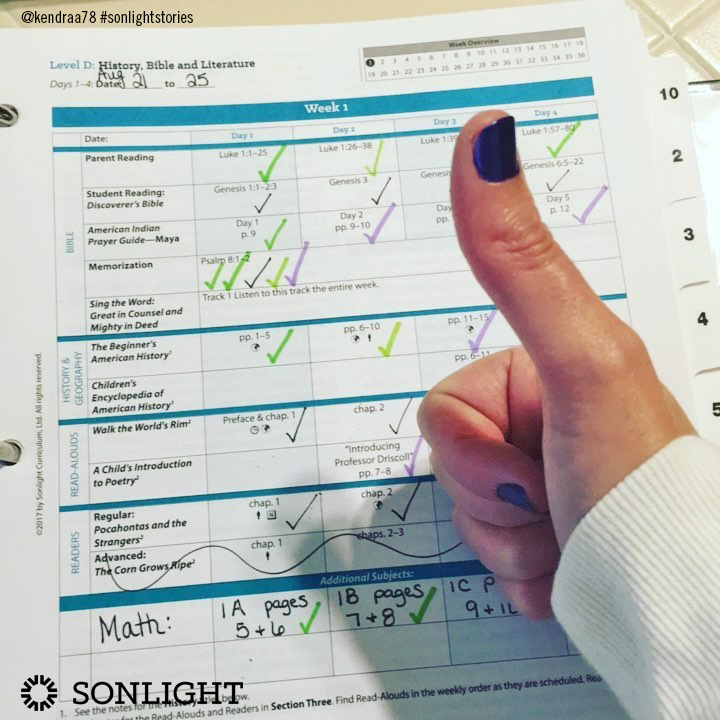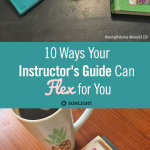Your Sonlight Instructor's Guide can flex, giving you a framework for your homeschool upon which you can modify, add to, and take away from.

Sonlight Instructor's Guides (IG) hold your lesson plans for 36 weeks—an entire school year—of homeschool. (Get samples here.) They have been likened to many different things to demonstrate their central place in a homeschool plan:
- a road map
- a buffet
- a starting point
- a foundation
- a brain
While the IG is a key component of your homeschool routine and daily plan, it is not a rigid taskmaster. No, your Instructor's Guide can flex, giving you a framework upon which you can modify, add to, and take away from.
Continue reading below or listen here:
We recently asked you (via the Sonlight Facebook page) how you adjust your Instructor's Guides to make them work for you. We were impressed by your willingness to customize your homeschool and the creativity you apply to your IG. Below are key ideas from that discussion. (Some responses have been edited for clarity and brevity.)
If you have additional ideas for how to make the IG flex for you, feel free to leave a comment below or share a photo and explanation on social media with #sonlightstories.
1. Add Your Own Notes
I like to have all my stuff in one place, so I draw more grid lines for math and handwriting and put them on the schedules in the Instructor's Guide.—Janine Bailey
2. Reframe Your School Year
This year, we're not thinking in terms of Monday to Friday. Instead we are thinking of each day as day x of 180. Our family schedule is not a steady, 4- or 5-day school week, so it's less stressful to say, "Today we're doing Day 18."—Belinda McCowan
3. Let the Kids Organize their Work
My seventh grader has homework and classes through our co-op. This means she does everything from the Instructor's Guide in four days. I make a copy of the assignment page, and let her choose how to divide it.—Beth Mayer Rose
4. Move Things Around
The Kindergarten Instructor's Guide has my children practicing writing their letters on Monday or day 1. I always push that back to day 2 or Tuesday. We start by working through the letter in Handwriting Without Tears on day 1 so they are more proficient at the letter before they do the Sonlight activity with it.—Bergan Blundell
We usually keep everything in the same week, but things will get moved around within that week so some days are longer and some are shorter to fit our lives. Also we do 6 weeks of school and then one week of break.—Andie Lucas Wade

5. Use a Separate Planner
We use the IG as a foundation and then write our schedule in a day planner because I like having everything in one place so I am not constantly flipping pages while working with the kids.—Lauren Shields
It works better for us not to use the big blue binder. This year I had my HBL, Science, and LA Instructor's Guides spiral bound. This allows me to keep each IG open to the day's page without its taking up my whole desk. It also allows for more flexibility in pacing and makes it easy for me to hand off a particular IG to an older student so they can self-direct.—Jody Moerman Faber
6. Totally Switch it Up
Since I have a fluent reader, I don't use the Readers for daily practice. Instead, I use them as rewards for reaching milestones, and set aside several at a time to use when we travel (car rides, flights, etc). —Gina Munsey
I hold off all the poetry readings for 1-2 weeks, then we sit down and read them all at once, sometimes as a tea time, other times just as a poetry time. —Shaina Naillieux
Since I am doing two HBLs with 3 children (and a toddler), I do a bit of combining. We do Bible together and I pick one Scripture to memorize together. I also choose one Read-Aloud to do together. The other Read-Alouds we enjoy via audiobook if possible. —Jenna Qu
7. Schedule in Blocks
We use block scheduling to minimize subject changes through the day. We do History and Language Arts on A days, Science and Read-alouds on B days, and Bible every day. —Lindsay Packard
I block schedule Science and History lessons. Generally, we do Science on Mon./Wed./Fri. and History on Tues./Thurs. Sometimes I reverse those, depending on which subject has more content that week. —Rebekah Coleman Wales
I love that the IG is a guide and things can be moved around to fit our week/day. We can load up one day and still complete everything that week without feeling overwhelmed. —Brittny Stellfox Smith
We do a 4-day school week because we have a co-op on Mondays. We do Math daily (Tuesday-Friday) and Reading daily, but I often do a whole week of History in one day and then a whole week of Science the next day. Sonlight keeps my kids engaged long enough to keep going, so we can knock out a full week and move on. —Sarah Smith
8. Work at a Slower Pace
We make each scheduled day in the Instructor's Guide last us two days. We have a lot of other subjects and co-op classes, so this lighter Sonlight schedule works for us. —Mary Gabert
We use the four day schedule and stretch it across 5 days. This allows for co-op time. Basically one day each week gets stretched across 2 days. —Sara Burke
We just work though. If we don't get something done, we do it the next day. One week takes longer than one week most times, but that's okay. We school year round! —Amber King
We rarely follow the schedule in the Instructor's Guide. Since we school year-round, we just pick up from where we left off. (Four weeks take us roughly six weeks to cover.)—Carol Stanbury
Because one of my children is dyslexic, we read one book at a time whether it's a Read-aloud or Reader. We sometimes follow the schedule, but more often than not we read at her pace. Some books don't get read, but she can always pick them up at another time. —Jennifer Conrad Garcia
9. Swap Out Assignments
I adjust the Bible portion to fit our personal beliefs (Torah Observant Christians) using a lot of what's given in the Instructor's Guide. —Amber King
We follow the Bible reading and discussion schedule, but do not use the books that go along with the Bible program in order to have more time to study God's Word in depth, apart from man's opinions. —Dana Pierce Halliday
10. Cross Out Boxes
Sometimes people feel a need to check every box on the Instructor's Guide. For me, it's just as legitimate to cross out a box that we chose to skip. Life on a farm is full of opportunities for hands-on learning, so we let formal bookwork takes a back seat at times. —Petrina Kelly
We don't do everything on the schedule. —Amber Leeming
We don't do the science experiments most of the time, but we always watch them on the DVD! I make Bible, Math, Writing, Language Arts, and Reading priorities that we cover most days. But for field trip days or days when we need a break, Science and History are the first to go!—Shirley Lopez Defendis
Simplify your homeschool and with a road map that flexes with you. Try three weeks of any Sonlight Instructor's Guide for free. Click here to get one for any level, preschool through twelfth grade.








I would like to see a blog article on the ways people document their work in Sonlight (for those who live in states that require documentation). For example, how do they document what is done each day, things that get moved around, or when a week doesn't get finished in a week, and where do they add math and electives? How do they document co-op or other classes on the 4-day grid when the co-op/classes fall on the 5th day? Also, do they use all three pages (HBL, LA, and Science) to document one week? That's a lot of paper by the end of the year. Or do they consolidate somehow? Pictures would be very helpful.